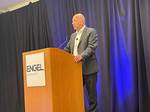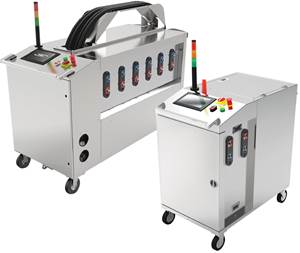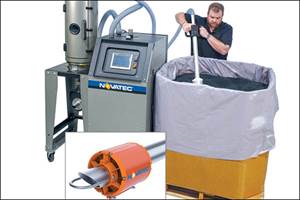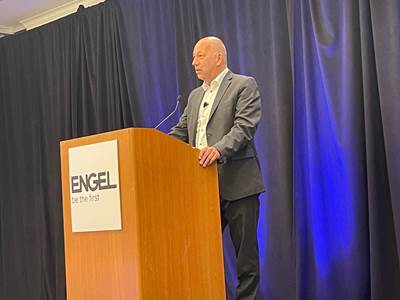In addition to exhibiting at the Battery show this October in Michigan, Engel held an open house in Austria with stakeholders in November to show its progress toward replacing steel and aluminum in the emerging application of electrical vehicle (EV) battery enclosures.
Michael Fischer, Engel’s business development manager for electrical mobility and smart panels, cites LMC Automotive’s (now GlobalData Plc’s) market forecasts to highlight the coming acceleration for the market. The powertrain composition ratio for global light vehicle sales report from GlobalData forecasts that the market share of internal combustion engines (ICE) will drop from 65.6% in 2024 to 22.3% by 2036, with battery electric vehicle’s (BEV) share rising from 12.6% to 52.9% over that same time period. When you mix in plug-in hybrid electric vehicles (PHEV) and full-hybrid electric vehicles (FHEV), the potential is even greater. “What do all these — BEV, PHEV, FHEV — vehicles have in common?” Fischer asks, “They need to store electrical energy for the motors.”
As a proof of concept, Engel, in collaboration with material supplier SABIC and sustainable product development firm Forward Engineering, developed an OEM-specific, high-voltage battery enclosure (HVBE) based on one already in production for Volkswagen’s ID.4 electric sport utility vehicle. “The goal is to deliver an innovative, cost-effective, and flexible scale solution for future EV battery enclosures,” Fischer says.

The tray features ribs and 37 metal inserts, and five standard fasteners molded into a single component.
Source: SABIC
This concept HVBE consists of a three-piece structure, including an injection molded cover and tray affixed to a structural steel underbody panel. The top cover is composed of three primary elements in a sandwich design in which a 1.9-mm thick layer of flame-retardant Stamax PP material is molded between two 0.3-mm organosheets inserted onto the A and B halves of the tool, which was built by Christian Karl Siebenwurst GmbH & Co. KG (Dietfurt, Germany).
Run on an Engel Duo 5500 combi M at the company’s tech center in St. Valentin, the cell utilizes an easix 6-axis robot with a dual-sided end-of-arm-tool (EOAT) to pick up two 50% glass-filled polypropylene (PP) organosheets and place them on either side of the tool, with the Siebenwurst mold holding the sheets in place and maintaining space between, which is then filled by a 7.5-kg (16.5-lb) shot of UL-verified flame-retardant Stamax PP from SABIC.
Around the outer edge of the finished part, there’s only the molded Stamax, while the rest of the 9-kg (20-lb) component features the sandwich structure. In the field, the top cover is tasked with containing any potential thermal runaway of the battery, preventing any potential fire originating in the cells from spreading through the vehicle. Specifically, the material must withstand the UL 2596 thermal runaway test. SABIC has proven out that a 4-mm thick sheet of flame-retardant Stamax 30YH570 can pass the test, which combines pressure, ablative force, heat and fire, with temperatures up to 420°C and internal pressures of 250,000 kPA (36,000 psi).
Trials with the mold and process began in August, and Engel outfitted the Duo 5500 combi M with a third injection unit for flexibility in future trials. For this process, the machine utilizes a 190-mm (7.5") diameter screw with an L/D ratio of 25.

Battery enclosure tray and cover on display at moldmaker Siebenwurst displaying the scale of the parts. Source: SABIC
This cover goes over the injection molded tray, which features ribs and molded-in fasteners for mounting connections and load transfer to the car’s underbody panel or body in white. Fischer says the basic concept for the tray was to integrate as much as possible into a single molded component. To that end, the design features 37 metal inserts and five standard fasteners that are insert overmolded into the final part. Automation is used to load the inserts and fasteners into another Siebenwurst tool. Testing on the tray, which has a design that features molded-in cooling circuits for the battery, has been running since April 2024, utilizing an Engel duo 4000 press.
While steel and aluminum currently dominate the sector, Fischer does point out some thermoplastic encroachment in the space. Specifically, Lucid Motors’ Lucid Air BEV features a one-shot insert-molded module housing, featuring insert molding of a contactor plate and applying a 20% glass-filled Lexan 3412ECR polycarbonate (PC) from SABIC. This component is molded by Plastikon Industries. Fischer and Engel maintain that thermoplastic enclosures, particularly when multiple components and features are integrated via molding in one shot, provide an attractive cost position for OEMs and their suppliers. In addition, if the carbon footprint of aluminum and thermoplastics are weighed in these parts, PA has 2.1 kg of CO2 equivalent for a kilogram of material, while cast aluminum comes in at 6.8 kg of CO2.
What’s Required
The opportunity is big both in the potential quantity of parts, but also in the individual size of these components, with Fischer saying future enclosures will measure 8 by 5 feet — a challenge to mold with the simplest materials. “We’re talking about shot weights that are going up to 75 kg with different, heavily filled materials,” Fischer says. These include PP and polyamides (PA), filled with glass fibers in ranges from 30 to 50%. Parts going up to 3 square meters in size, would require clamp forces up to 11,000 tons.

Siebenwurst built the molds for the battery tray (pictured) and cover. Source: Siebenwurst
In addition to its validation and research work with SABIC and Forward Engineering, Engel is also collaborating with Envalior on battery housing concepts, targeting PA structures, as well as fully or partially integrated organosheets or UD tapes, metal inserts for connections and integrated ribs for impact resistance.
In addition to outstanding mechanical properties, many of these materials and components will need to offer electromagnetic shielding (EMS) and flame-retardant (FR) capabilities. For the trays the hold the battery cells, long-glass fiber PP with FR V0 rating would be the base materials, with UD tapes, rods and organosheets applied as needed. The module housing and control box would use glass-filled PC and short-glass-fiber-filled PA and PP. Here too, the components need FR V0 rating and EMS. For the cover and the tray, postmold behavior, including potential warpage, must be considered. Fischer says in addition to helping meet the FR requirements, the organosheets also alleviate potential warpage.
Plasticizing Concepts and Process Requirements
Fischer says a standard 3-zone screw for materials reinforced with short glass fibers can be applied, while for long glass fiber materials (like SABIC’s Stamax), screws with geometries especially designed for maintaining fiber length should be used. He adds that two injection units for these parts can provide more flexibility and, given the shot volumes that need to be prepared, keep screw diameters in more conventional ranges.
As another means of maintaining longer fibers, Fischer says a two-stage process — where glass fibers are added into the melt in a second screw after a primary screw has prepared the materials — is an option. Engel’s own internal tests of such a 2-stage process showed significant increases in fiber length compared to single-stage plasticization, with fiber lengths measured after the nozzle. Fischer notes that this two-stage concept also opens the door for the introduction or regrind and recycled material into these parts. In terms of injection pressure, forces equal to or greater than approximately 22,000 psi are need with a metering stroke of 1.5 to 2D, or one-and-a-half-to-two-times the screw diameter. Use of a sequentially valve-gated hot runner system, with cascading injection across multiple gates, is also suggested.
“Based on testing, Engel remains open material wise,” Fischer says. “I personally believe it must be cost-effective and fulfill all the needs from the OEM. We’re preparing for all relevant materials. Different materials will have different properties, and these will be reflected in the design.”

Related Content
System Offers 'Lights Out' Mold-Channel Cleaning & Diagnostics
New system automatically cleans mold-cooling lines—including conformal channels—removing rust and calcium, among other deposits, while simultaneously testing for leaks, measuring flow rate and applying rust inhibitor.
Read MoreNew Technology Enables ‘Smart Drying’ Based on Resin Moisture
The ‘DryerGenie’ marries drying technology and input moisture measurement with a goal to putting an end to drying based on time.
Read MoreScaling Up Sustainable Solutions for Fiber Reinforced Composite Materials
Oak Ridge National Laboratory's Sustainable Manufacturing Technologies Group helps industrial partners tackle the sustainability challenges presented by fiber-reinforced composite materials.
Read MoreExtrusion Technology Extended to Injection, Enabling Up to 100% Regrind Usage
Twin-barrel (shot-pot) press can handle more regrind, offers other benefits to molders.
Read MoreRead Next
Engel Installs Massive Injection Molding Machine for Trials, Testing
The Austrian company’s large-machine plant in St. Valentin now has a duo 5500 combi M press, with nearly 6,200 tons of clamp force and shot weights up to 93 lbs, available for customer trials.
Read MoreSPE Automotive Awards Applaud ‘Firsts’ and Emerging Technologies
The 51st annual SPE Automotive Innovation awards gave nods to several ‘firsts’ and added alternative vehicle systems category.
Read MoreGetting Charged Up About Electric Vehicles
Metal-to-plastics replacement stories are a classic of the genre for plastics publishing, and nowhere more so than in the automotive space.
Read More























